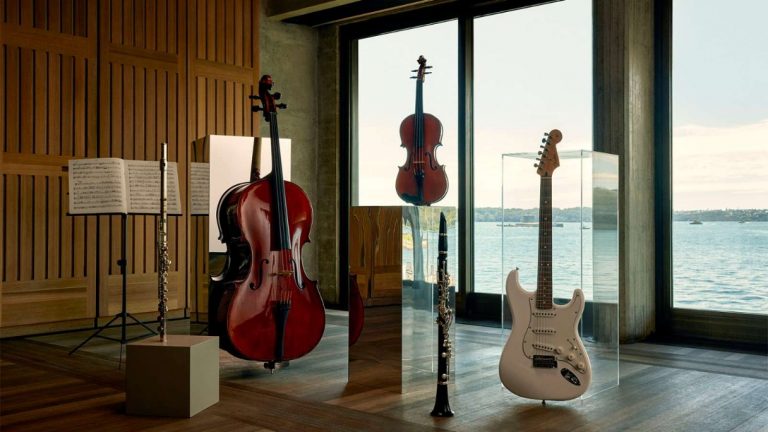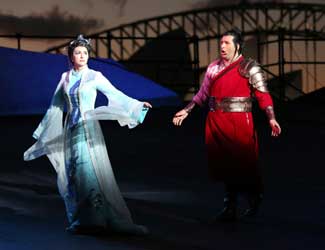‘Giasone’ – It’s Really About The Women


Don’t be misled by the seemingly masculine focussed title and synopsis of Cavalli’s Giasone. The opera which Pinchgut Opera is presenting with an all Australian cast in Sydney this week is as much about the rivalry between the two powerful women who are at the centre of the drama, distracting the hero from his not-so-single-minded search for the Golden Fleece.
Giasone became the most frequently performed opera of the entire 17th century after its premiere in Milan in 1649. It was the only collaboration between Cavalli and the librettist Cicognini, and toured to Lucca, Florence, Bologna, Naples, Perugia, Rome (a version edited by Stradella),Vicenza and other centres around Italy. The critic Crescimbeni called it “the first and most perfect drama in existence.”
Vying for Giasone’s attentions are Medea, Queen of Colchis, sung by Celeste Lazarenko and Isifile, Queen of Lemnos, sung by Miriam Allen, both roles for sopranos. I met with the two adversaries during a break in rehearsals at the Opera Centre in Sydney’s Surry Hills. Their careers have run in parallel in many ways. They are both close in age and after early training in Australia, they each moved to England. Although they had heard of each other, they had never met until they began to work on Giasone. Miriam Allen continues to be based in England whilst Celeste Lazarenko returned to Australia in 2011. Neither of them can contain their excitement and passion in talking about Giasone. One continues where the other left off, or, their alternating sentences become part of a larger singe conversation.
Tellingly, Celeste is dressed in white and presents as more introspective. Miriam is dressed in black, albeit with white polka dots, and comes across as more light hearted. Celeste affirms this observation. “Absolutely – the two women are the yin and yang, which is why the audience can identify with both of them. They are extremes but they play out what women can be. They are strong characters who are in control of the drama. The opera is written by men and named after a man but women are the driving force. Our characters represent different kinds of love. They’re opposites – black and white – and I’m sure that at some point in my life I have been either of those characters.”
“We don’t see each other for most of the opera and then we have a rather ugly confrontation half way through.” ( “It’s a little awkward” says Miriam with a dry giggle). “But then the duet we sing at the end is really lovely.”
Celeste continues: “Medea is very interesting because she represents what at the time would have been thought of as unwomanly virtues. She’s asked in the opera what she cares about and she says she doesn’t care about her husband or her son or her homeland. She has no loyalty except to herself and that’s a big revelation of the female character. Also, I had to in some ways, make her magical because she couldn’t t have possessed those powers unless she was a witch – like Alcina.”
In contrast, Miriam sketches the persona she takes on as Isifile. “Isifile doesn’t have the same characteristics of Medea. She is not magical; she doesn’t have grandeur, or power and she certainly doesn’t appear to be calling the shots, but it is her emotional side that drives her and what she wants for her children. She is at her most emotional and vulnerable.”
What was the secret to the popularity of Giasone in the 17th century? Miriam believes there is a universal appeal. “This show has something for everyone. There are laughs, there are tears, there silly silly jokes, and it has stood the test of time. It was entertaining 400 years ago and it’s still entertaining today. “
Celeste picks up the thread: “ Like Shakespeare, it is eternal. It can speak to a contemporary audience – like a beautiful piece in a museum. We are the curators. Fundamentally, we haven’t changed – we’re human beings with the same love, fears and doubts, suspicions and rivalry – they’re all contemporary emotions. Even our ‘hero’ is in fact an anti-hero. He is flawed just like all of us and we can identify with that.”
Miriam points to another element of Giasone which added to its popularity and longevity. “So many times we have said in the last few weeks, not only is the music of Cavalli brilliant, but the libretto is genius – the double entendres, the cleverness of some of the statements, the ambiguity where you could be speaking about either character. It’s extraordinarily entertaining.”
Both women and enthralled at the prospect of working with director and co-designer Chas Rader-Shieber and conductor and harpsichord player Erin Helyard who have made the libretto come alive in this production. Giasone was one of the first operas in which arias and recitative were made distinct. Oxford on line says that in Giasone, “formal distinctions were clarified by dramatic function, with recitative reserved primarily for action and commentary and arias for formal songs or moments of intense, reflective feeling.” “It will throw your ideas of recitative and aria completely out of the window” says Miriam with some degree of mischievous delight. “The recitative is always furthering the plot and the drama. It is full of text….”
Celeste pipes up: “….and the ornaments might be confronting because the audience may not have heard them before – all due to the genius that Erin is. When I first picked up the score and asked him for material about the ornamentation that was used in these days, he said “‘You’re looking at the source!” He’s researched all of this thoroughly. Some of the ornamentation is quite shocking and you might think that it’s not right but we did it as true to Erin’s scholarly ideas as we possibly could…..”
Miriam….”The ornamentation always reflects the character and always reflects the text. That is an absolutely key and that is where Erin will always start. Before he goes into historical performance style, he will begin with what is to be coloured by ornamentation and why. The basic rules apply – it’s got to be in time and in harmony with the music. It’s always to add meaning to the text and has nothing to do with us ornamenting for the sake of it.”
I am reminded too by Miriam that the notational devices of the time was very rudimentary. The limitation in conveying time, rhythm and pitch placed the responsibility firmly on the singers to interpret that framework, creating the atmosphere and drawing the character with that ornamentation. Celeste agrees that much as she loves singing from a score where the instructions for performance have been made explicit by a composer, older works come with minimal musical instructions about how they should be performed, honing a double edged knife which creates a sense of freedom, but also the responsibility of looking at the score and interpreting accurately. “We’re not just singing off the page. We’re the custodians of this performance style.”
Perhaps it doesn’t matter who had the last word.’ We’ re inhabiting a sound world and its characters from 400 years ago. I hope that people will see the hilarity as well as the tragic nature of the personalities.”
Shamistha de Soysa for SoundsLikeSydney©.
Giasone is at the City Recital Hall Sydney on Saturday 7th December and Monday 9th December at 7.30 pm and Sunday 8th December at 5 pm.
Tickets from $30.
Bookings: http://www.cityrecitalhall.com/events/id/1480/Giasone-by-Cavalli/






